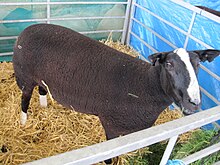Zwartbles
The Zwartbles is a Dutch breed of sheep , the 1930 in the 1920 / years from the intersection of Schoonebeeker Heath sheep with Texel and dairy sheep bred and as improved Schoonebeeker was called. Zwartbles sheep are strong, medium-sized sheep with a good milk yield . Mother animals can raise the lambs, which often come from multiple births, without any problems.
features
The Zwartblessschaf is a very large-framed, well-muscled sheep with an elongated head and long legs. It is hornless, has black or brown-black wool and has a long, little woolly tail. The ewe reaches a shoulder height of approx. 75 cm and a weight of 50 to 60 kg, according to the regional association also a weight of 75 to 100 kg. The trestle can be heavy at a height of 85 cm to 130 kg.
The head is hornless and the bridge of the nose straight. The ears are horizontal. The dams have a well-developed udder and a good milk production, so that the lambs, which often come from multiple births, can be raised without any problems. The heat is seasonal, an initial admission in the first year with at least 50 kg live weight is possible. The foundation is well established, dry and not too fine. The trunk is deep and wide. The back, loins and legs are well muscled.
Typical are the white blaze on the forehead, which also gave it its name, the white feet and the white tip of the tail. The tail is not docked in this breed of sheep.
use
The Zwartbles is one of the meat sheep breeds and is counted among the grazing sheep in the Netherlands, along with dairy sheep and Texel sheep . The breed is considered to be very willing to perform with corresponding demands on husbandry and feeding. It is mainly held in the hobby area.
Zwartblessen are considered an ideal breed for direct marketers. They are not fatty, so that carcasses of 22 to 25 kilograms are produced with only a small amount of fat. Their meat has a mild, very fine taste. The lambs are very healthy and can achieve daily weight gains of more than 400 grams with additional concentrated feed . With pure pasture husbandry with little or no additional feeding of concentrated feed, they are ready for slaughter at four to eight months.
Zwartblessen have very good maternal characteristics, give birth easily and, with adequate feeding, have enough milk to raise triplets without help. In the births registered in the stud book between 1990 and 1995, the average lambing rate was slightly more than two lambs per litter, triplets were more common than singles. The likelihood of multiple births increases with the age of the ewes:
| Age | Number of births | Average number of lambs |
|---|---|---|
| Yearlings | 3573 | 1.63 |
| 2 year old | 3376 | 2.09 |
| 3 year old | 2281 | 2.28 |
| 4 year old | 1404 | 2.35 |
In Zwartbles sheep, scrapie resistance is to be genetically fixed. In order to achieve this breeding goal , specifically genotyped bucks have been used for several years.
literature
- Deborah Robson, Carol Ekarius: The Fleece and Fiber Sourcebook: More Than 200 Fibers, from Animal to Spun Yarn. Storey Pub, North Adams, Mass 2011, ISBN 978-1-60342-711-1 .
- Sue Kendrick: Lambs for the Freezer: A Guide to Small-Scale Production. Crowood Press, 2011, ISBN 978-1-84797-269-9 .
Web links
- Breed and breeding goal description: Zwartbles. In: schafe-sind-toll.com. Association of German Sheep Breeding Associations (VDL), January 18, 2013 (PDF file; 550.8 KB)
- Breed description sheep: Zwartbles sheep. In: Central Documentation of Animal Genetic Resources in Germany (TGRDEU). Federal Agency for Agriculture and Food (BLE)
- Nederlands Zwartbles Schapenstamboek . In: nzs.nl ( Dutch )
- About the Zwartbles sheep ( Memento from December 6, 2013 in the Internet Archive ). In: zwartbles.de. Zwartbles sheep in the Taunus (including information on the breed standard of the NZS)
- Zwartbles sheep breeding Jürgen Sönnichsen, Wobbenbüll . In: zwartbles-soennichsen.de (with breed history and picture gallery)
Individual evidence
- ↑ About the Zwartbles sheep. In: Zwartbles Schafe im Taunus. Archived from the original on December 6, 2013 ; accessed on May 2, 2013 (including information on the breed standard of the NZS).
- ↑ a b c Breed description Zwartbles. In: schafzucht-niedersachsen.de. Association of Sheep Breeding Associations Lower Saxony, accessed on May 2, 2013 .
- ↑ Breed description sheep: Zwartbles sheep. In: Central Documentation of Animal Genetic Resources in Germany (TGRDEU). Federal Office for Agriculture and Food (BLE), accessed on May 2, 2013 .
- ↑ Zwartbles. (No longer available online.) In: schafzucht-kiel.de. Schafzuchtverband Schleswig-Holstein, formerly the original ; Retrieved May 2, 2013 . ( Page no longer available , search in web archives )
- ↑ Domestication / History. In: Zwartbles-Schafzucht Wobbenbüll. Jürgen Sönnichsen, accessed on May 3, 2013 .
- ↑ Breeding goal. In: Zwartbles-Schafzucht Wobbenbüll. Jürgen Sönnichsen, accessed on May 3, 2013 .

